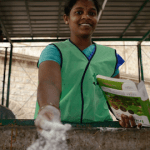Reimagining the World’s Dirtiest Job: How Pit Vidura is Professionalizing Waste Management
Sanitation: It isn’t something that most people enjoy thinking or talking about. But it’s a grave and urgent global challenge. Lack of adequate human waste management can expose communities to a wide variety of dangerous diseases, including cholera, diarrhoea, dysentery, hepatitis A, typhoid, polio, intestinal worms, schistosomiasis and trachoma. Unsatisfactory sanitation conditions cause an estimated 280,000 diarrhoeal deaths per year. That’s equivalent to 767 deaths every day, 32 every hour or one every two minutes. The time has come to stop ignoring this problem and take action.
Unfortunately, though global access to toilets is increasing, safe management of human waste remains a problem. Around 2.7 billion people – 35 percent of the world’s population – use “on-site sanitation” systems, which include pit latrines and septic tanks, and are not connected to sewer systems. When they become full, they need to be emptied for households to have continued access to a toilet.
That’s the challenge in Kigali, Rwanda, a city with over 1 million people, but no sewer system. When residents’ septic tanks and pit latrines fill up, they need to be emptied – and that’s where Pit Vidura comes in. The company aims to provide the missing link between toilets and safe disposal treatment. Our work focuses on how to safely empty, transport and dispose of waste from full on-site sanitation systems in Kigali. Specifically, we focus on how to do this inclusively for people who can’t afford services and/or live in hard-to-reach areas.
Since 2016, Pit Vidura has been offering safe, hygienic pit latrine and septic tank emptying services for households in the city. While trucking services exist to empty septic tanks in its more affluent areas, Pit Vidura is the only service working in low-income areas and protecting the public and environmental health of these communities by separating them from their waste.
A widespread problem
In many cities in Sub-Saharan Africa, the best option for emptying a full pit latrine is to hire an exhauster truck, which will pump the waste from the pit into a tank on the truck. However, many people can’t afford to hire such trucks. Many poor households are also located in dense areas with limited road access, especially for big vacuum trucks. Thus, for many low-income households in dense informal areas, when pits are full of waste, the only option is manual pit emptying. During manual emptying, an emptier will use a shovel and bucket to scoop waste out of the pit in a practice that is slow and dangerous. After extracting the waste, the emptier will dump it into a ditch or nearby waterway, contaminating the environment and creating a serious public health hazard.
The practice of manual emptying is unsafe for everyone involved, particularly the emptiers themselves. Sometimes it is necessary for them to climb into the pit, wade in human waste and remove it bucket by bucket. During the job, emptiers are exposed to pathogenic fecal sludge – and they often perform the job without any protective equipment (boots, gloves, etc.). In most countries, manual emptying is illegal because of its obvious public and environmental health consequences. This illegality, combined with the unhygienic nature of the work, means that manual pit emptiers also face heavy stigma within their communities. In many countries, they work at night under the cover of darkness, and inebriate themselves to withstand the dreadful conditions. All of these practices combine to create the perfect storm for the spread of disease – to the emptiers doing the work, and to the surrounding community.
A difficult challenge
Despite the fact that almost a quarter of the world’s population (1.77 billion people) use pit latrines, manual emptying is a largely unsolved issue. This is due to a combination of factors, including the lack of an alternative solution and the international focus on building, rather than maintaining, pit latrines.
There are also economic and societal factors that make the move away from manual emptying difficult. First and foremost, manual pit emptying is cheap. It doesn’t involve the use of pumps, trucks or fuel. The main cost is labor and, because many manual emptiers don’t have another option for employment, their wages are low. And for low-income families, the large upfront cost of hiring an exhauster truck presents a barrier to switching from manual pit emptying to a safer alternative.
Another factor that supports the continued practice of manual pit emptying is societal. People are simply used to using manual pit emptiers and, as the saying goes, “If it’s not broken, don’t fix it.” This stems partly from a lack of knowledge about the harmful health impacts of manual pit emptying, and also from local authorities, who often turn a blind eye to the practice, even in areas where it is illegal.
An innovative solution and approach
Pit Vidura’s vision is to end the dangerous practice of manual pit emptying by offering safe hygienic pit emptying services for low-income families in the dense urban neighborhoods of Kigali. We view the sanitation problem as primarily one of logistics.
Our model treats the business as a “live lab,” integrating research and development with the running of the actual enterprise. To keep the service costs low enough for low-income households in Kigali, Pit Vidura empties clusters of two or more neighbors at once. This reduces the fuel costs and time associated with driving between geographically disparate customers. The savings can then be passed on to the households. The price for emptying in a cluster of three or more neighbors is $60, compared to the $100 charged by traditional exhauster trucks. On average, households in Kigali empty their pits every 7 years, making Pit Vidura’s service $8.50 per household per year, or $1.70 per person per year. Compare this to the cost of other exhauster truck services, $2.85 per person per year, or the average cost of $55 per person per year for a sewer system in Dakar, Senegal (which is often used as a reference point for the cost of sewer-based systems in Africa).
Testing new ideas in the context of a real business means that Pit Vidura has a rapid feedback loop that allows the team to immediately understand how new approaches work in the African low-income household market. We’ve also developed numerous mechanical innovations that allow our emptying teams to physically reach households in dense, low-income areas that are far from the main roads. One of these recent innovations is an adaptation of a traditional exhauster truck, enabling our teams to empty full pits from up to 200 meters away. This means that households who historically were unable to access many basic services now have a safe and affordable way to manage their waste. Pit Vidura has also developed several mobile apps that help track truck logistics, and ultimately help the team understand how to reduce the costs of safe waste removal and transport.
Professionalizing a Marginalized Sector
Pit Vidura is also aiming to professionalize the emptying sector, which has remained largely unstandardized, unregulated and informal. In doing so, we’re transforming a historically stigmatized occupation into one of pride. The pit emptying team is composed of former manual pit emptiers who are trained by Pit Vidura to use mechanized emptying tools, provide quality customer service, price emptying jobs in a standard fashion, and uphold high health and safety standards. The company also focuses on the education of our customers: We have launched campaigns to highlighting the importance of hygienic sanitation practices and proper septic tank/pit latrine maintenance.
As a young enterprise, we’ve faced many challenges; everything from securing government approvals, to repairing faulty equipment, to pushing behavior change in low-income households. These problems are magnified by the fact that we work in an environment where bureaucracy is slow, the supply chain for truck and pump replacement parts is largely undeveloped, and building trust with customers takes a significant amount of time.
Despite these challenges, we’ve managed to build, run and sustain a business model that provides a necessary service in a standard, professional and dignified way. In the coming months, we plan to refine a set of tools and knowledge that will help existing exhauster truck entrepreneurs in other emerging markets professionalize and grow their businesses by serving more low-income households.
The team at Pit Vidura has already emptied over a thousand pit latrines (representing over two million liters of waste) and we’re looking forward to emptying a thousand more. Each empty pit brings the world closer to the UN’s SDGs – and closer to a world with safe sanitation for all.
Katie Sottilare is an undergraduate biology student at MIT and a communications intern at Pit Vidura.
Photo provided by author.
- Categories
- Social Enterprise, WASH
- Tags
- public health, waste



